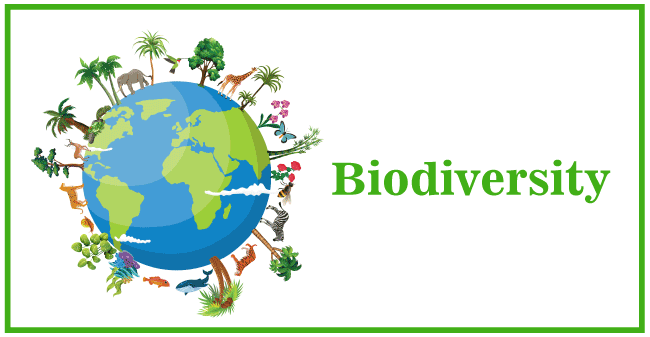Threats to Biodiversity
“Biodiversity refers to the variability of life that may be found in a given place, including animals, plants, fungi, microbes, etc. Each of these species interacts with each other in ecosystems to maintain equilibrium and support life. Biodiversity provides humans everything such as food, clean water, medicine, and shelter, and more.

Changes and extinctions are occurring at an extraordinary rate as of now. The fundamental causes of biodiversity loss, such as human population increase and overconsumption, are usually complicated and involve a number of interconnected variables. Here are some of the major challenges to biodiversity.
1. Human Activities and Loss of Habitat:
Human behaviors are thought to be causing a loss of biological variations among animals and plants that is 50 to 100 times quicker than the normal rate of species loss around the planet in the absence of human activities. In rich biomes, tropical forests and coral reefs are two of the most popular species.
Conversion of tropical forests to other land uses is a hazard, and coral reefs are being over-exploited and contaminated at an astonishing speed. If the current pace of tropical forest loss (approximately 1% per year) continues for the next 30 years, the predicted number of species that the remaining forests might support will be reduced by 5 to 10% compared to the forest without human intervention.
According to some assessments, up to half of all mammalian and avian species could become extinct in the next 200 to 300 years. Biodiversity loss can be caused by a variety of factors, including:
- Habitat destruction and conversion
- Species overexploitation
- Disconnected areas of indigenous vegetation
- Air and water pollution
Human-caused climate change will become a major influence in lowering biological/biodiversity in the future decades. Economic growth and related needs, such as the increased demand for biological resources, are driving these pressures on biodiversity to a considerable extent.
Through the loss of usable materials, genetic stocks, and the functions of intact ecosystems, activities that degrade biodiversity imperil economic progress and human health. Food, timber, and medications, as well as recreational and tourism resources, have all been lost. Decreasing genetic diversity, like losing species diversity, increases the likelihood of subsequent environmental disturbance resulting in significant decreases in the goods and services ecosystems can supply. Pollination, soil fertility maintenance, flood control, water purification, waste assimilation, and carbon and other nutrient cycling are all hampered by reduced biodiversity.
2. Deforestation:
Forest ecosystems support up to 80% of the world’s terrestrial biodiversity, produce wood fiber and biomass energy, and are important components of global water, energy, and nutrient cycles. In many regions of the world, forest ecosystems are being removed and degraded.
According to current forecasts, wood demand would roughly quadruple over the next 50 years, making growing the use of sustainable forest methods increasingly difficult. Forest deprivation is a major source of greenhouse gas emissions, as well as a threat to biodiversity and potential supply limits for forest products. About a third of the carbon in forest ecosystems is stored above ground in trees and other vegetation, with the other two-thirds being stored in the soil.
3. Desertification:
The main drivers of biodiversity loss are desertification and deforestation. Agriculture’s expansion has a significant impact on both processes. The extinction of vital plant and animal species is a direct result of deforestation. Poor land management causes desertification, which can be aggravated by climatic variations. Ploughing the soils when converting wildlands to agriculture is common, resulting in a 25 to 40% decrease in soil organic matter over twenty-five years in temperate countries.
Decreased soil organic matter is always a sign of soil deterioration, and it’s frequently accompanied by decreased water infiltration, fertility, and fertilizer retention. Plowing also compromises soils to water and wind erosion, resulting in widespread pollution of freshwater supplies.
4. Marine Environment:
Oceans are extremely important to the world environment. Because they span 70% of the earth’s surface, they have an impact on global climate, food production, and economic activities. Despite these contributions, the coastal and marine environments are quickly deteriorating in many parts of the world.
Degradation, resources’ ecological degradation, expansion of important ecosystems like marshes and wetlands, and poor land-use techniques have resulted in severe declines in near-shore fisheries production and water biodiversity in coastal areas where human activities are concentrated.
5. Increasing Wildlife Trade:
Trade is another source of biodiversity loss that causes tension between the North and the South. The annual value of the global wildlife trade is estimated to be more than $20 billion. Globally, at least 40,000 primates, 90,000 African elephant ivory, one million orchids, four million live birds, ten million reptile skins, fifteen million furs, and over 350 million tropical fish are traded.
6. Climate Change:
As the temperature warms, species in both hemispheres will migrate to higher latitudes and altitudes. CO2 levels in the atmosphere have an impact on plant physiological function and species composition. Climate change also threatens aquatic ecosystems such as coral reefs, mangrove swamps, and coastal wetlands.
In theory, coral reefs, which are among the most ecologically diverse marine ecosystems, are vulnerable to fluctuations in sea level and ocean temperature. Whereas maximum coral systems should be able to develop quickly enough to survive a rise in sea level of 15 to 95 centimeter’s over the next century, sustained warming of several degrees Celsius would put many of these systems at risk.
7. Exotic Species Introductions:
Alien species, such as the Codling Moth, pose a significant threat to BC ecosystems. The deliberate and unintentional introduction of a wide range of species into ecosystems where they do not belong has resulted in ecosystems that are vastly different in structure and function from those that existed previously. Exotic species are often brought into ecosystems without their co-evolved predators and parasites, allowing them to outcompete native species with similar ecological requirements.
